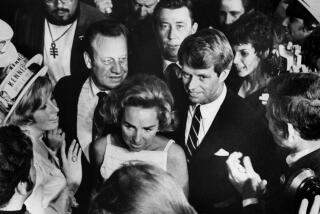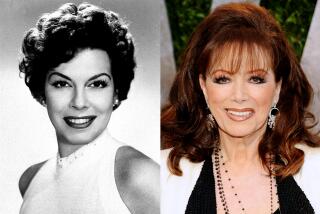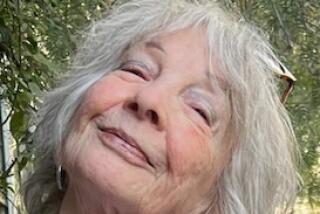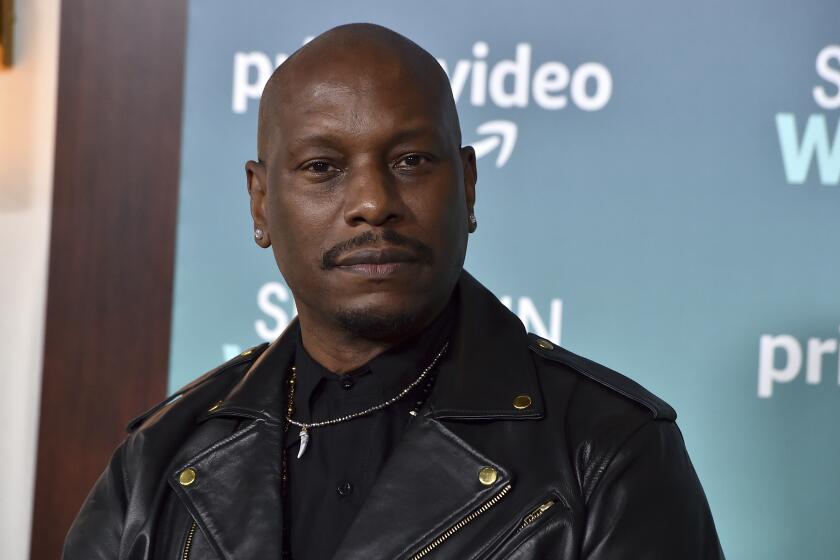Jacqueline Onassis Dies; First Lady of ‘Camelot’ Was 64
NEW YORK — Jacqueline Bouvier Kennedy Onassis, the most elegant, cultured yet tragic First Lady of the modern era, died Thursday night of cancer. She was 64.
At her side in her spacious 5th Avenue apartment were her daughter, Caroline Kennedy Schlossberg, 36; her son, John F. Kennedy Jr., 33, and her longtime companion Maurice Tempelsman, a New York financier and diamond dealer.
“Jacqueline Kennedy Onassis was a model of courage and dignity for all Americans and all the world,” President Clinton said in a statement. “More than any other woman of her time, she captivated our nation and the world with her intelligence, elegance and grace.”
Mrs. Onassis had entered New York Hospital-Cornell Medical Center on Monday for further treatment of non-Hodgkin’s lymphoma. But she asked to return to her apartment that faces Central Park on Wednesday after doctors decided that the disease could not be stopped.
“There was nothing more to do for her,” her close friend Nancy Tuckerman told reporters. As word of the gravity of her illness spread Thursday afternoon, crowds flocked to an exhibit in her honor at the John F. Kennedy Library in Boston to view, among other memorabilia, a film of her tour of the White House as First Lady and to gaze admiringly at the maroon-and-cream-colored gown she wore more than 30 years ago at a White House dinner.
And it is, in fact, that vision of the First Lady--in a satin ball gown or perhaps trim in a tailored suit and pillbox hat--that most Americans will recall when they remember Mrs. Onassis.
As the 31-year-old wife of John F. Kennedy, the 35th President of the United States, she set a standard of elegance, and with her handsome husband enlivened the country with a sense of youth and beauty. She immediately made a mark by transforming the White House from the dowdy rec room of the Eisenhower years into a historic jewel that was important not only on state occasions but also on weekdays when it was open for public tours.
Yet so many indelible images remain of the lithe, dark-haired First Lady. There were the Life magazine pictures of her as a young mother at Hyannis Port, slender in Capri-style white pants and a striped shirt, chasing after her two small children on a warm summer’s day. There was the desperate wife climbing over the back seat of the limousine where her husband lay mortally wounded in Dallas in 1963. And finally, there was The First Widow, standing in low heels, tears barely visible behind a black veil as her 3-year-old son saluted the riderless horse at her husband’s funeral.
For the sake of fairy tale, the images should have ended there, with the 34-year-old widow quietly moving into the countryside to ride horses, raise her children and preserve her husband’s legend.
Theodore H. White, in his memoir, “In Search of History,” recalls the night in Hyannis Port when he talked with then-Mrs. Kennedy from 8:30 in the morning until midnight about her late husband’s White House years. She purged herself of her husband’s bloody assassination after the long day, he said. Then she found the thought she wanted.
“Her message was his message--that one man, by trying, may change it all,” White wrote.
Thus, he said, she tried to frame her husband’s legacy as the legend of Camelot.
But Jackie Kennedy’s fable did not quite stick. The myth was so often sullied by revelations of her husband’s mistresses and manipulative behavior that periodic remembrances of Camelot are often tempered.
And for the young widow, life also evolved.
She went on to live essentially two more lives. First, overseas with the wealthy and flamboyant Greek shipping tycoon Aristotle Onassis, who many said she married to escape a recklessly voyeuristic world. And later in a quiet, elite corner of Manhattan where she doted on her three grandchildren, worked as a book editor and made the social rounds for worthy causes.
And on occasion, much the way she did as recently as Sunday, Mrs. Onassis simply blended in with the other strollers in Central Park, usually holding hands with Tempelsman or trailing her toddling grandchildren.
She survived being among the greatest female icons of the 20th Century by behaving almost perfectly. She maintained a rare grace and composure, refused to give in to America’s obsession with personal revelation and she not only outlived two husbands but prevailed over their disloyalty, achieving fame and fortune on her own terms.
Known in later life for her trademark oversized sunglasses and by monikers such as “Jackie O,” she has more entries in the Reader’s Guide of Periodicals than almost anybody else (and that does not include the 32 books about her). Yet she almost never talked to the media.
While she may have been the most public “private” person in the world, to her colleagues in the publishing world where she toiled for 16 years, she was nothing less than intimate.
Paul Golob, now a senior editor at Times Books who worked with Mrs. Onassis at Doubleday, said she took a genuine interest in young people in publishing and was often willing to take them under her wing. After Golob left Doubleday four years ago, they exchanged notes and she even invited him for tea and finger sandwiches in her apartment.
On another occasion, during a discussion on a book he was working on about politics, Golob recalled how “she got a faraway look and told me how Jack would take her into the Senate Gallery and point out Senators Russell and Mansfield. It was as if it were my mom telling me about what she and dad had done when they were first married. It was very personal and intimate.”
And it was not uncommon for the people who worked with her, Golob added, to see her in typical editor motion: “sprinting down the hall to get something into someone’s hands on deadline.”
This incarnation of her--happy, caught up in a workaday job--is quite jarring considering the beginnings of Jacqueline Bouvier. She was born to an aristocratic family in Southampton, N.Y.
Her father was John Vernon Bouvier III, an exotically handsome bon vivant known as “Black Jack” who dwindled a $750,000 inheritance into a $100,000 estate. He was a serial womanizer who could not even get through his honeymoon with Janet Lee--daughter of a self-made millionaire--without launching an affair.
After having two daughters--first Jacqueline and then Lee, 3 1/2 years later--the Bouviers divorced. Jacqueline was only 10 years old. Though the girls lived with their mother, it was their father whom they adored and who continued to shape their sensibilities and direct their education. Their mother, meanwhile, plied them with a passion for social climbing--and money.
Jacqueline, who was studying ballet and taking riding lessons by the time she was 5, attended the best schools: Miss Porter’s and Miss Chapin’s, where she listed in her yearbook that her goal was “not to be a housewife.”
Unhappy at Vassar College, she rebelled by eating pastries and studying all night. After a junior year at the Sorbonne in Paris she returned to finish her degree in 1951 at George Washington University. Instead of taking the Prix de Paris essay prize that she won from Vogue magazine and spending a year in Paris, she accepted a $42.50-a-week job as an “inquiring photographer” at the Washington Times-Herald.
It was then that the 23-year-old Bouvier met Jack Kennedy, 12 years her senior, at a dinner party at the home of his friend, journalist Charles Bartlett. At the time Bouvier was engaged to a New York stockbroker, but she apparently couldn’t resist a dashing young man so much like her father.
From accounts in several books--both learned and lurid--the young Jackie comes across as a strong-minded, tough, yet sensitive woman who was attracted to the junior congressman from Massachusetts both for love and for his considerable family wealth. He was worth $10 million, so it was said, at the time of their meeting and her family’s fortune was virtually dried up.
When they married in September, 1953, in front of 3,000 guests, there is sufficient evidence that Jackie Kennedy had been appropriately warned about her husband’s womanizing, his boisterous if not overbearing family and the Kennedy obsession with athletics. (She broke an ankle early on trying to join in a game of touch football.)
The Kennedy sisters did not much take to Jackie, ridiculing her little-girl voice and pronouncing her name “Jacklean” to rhyme with queen. She didn’t much like them either, calling them “the rah-rah girls.”
In the first six years of their marriage, John Kennedy spent most of the time campaigning, traversing his home state, traveling the country. Mostly, his wife disdained the role of campaigning spouse, apparently out of shyness and a dislike of crowds.
Once in the White House, though, she fulfilled seemingly well the role of the pre-feminist First Lady: She was the epitome of womanhood. Hers was not the job to advise on health care and foreign policy; rather, she dressed like a princess, hosted extraordinary parties and oversaw the upbringing of her children with the help of a British nanny.
But America seemed willing to forgive such upper-class indulgences. Following in the footsteps of the matronly Mamie Eisenhower, Jackie, as the country came to think of her, was a glamorous model for women to pattern themselves after. When she made it a mission to bring art and culture to the White House, it was as if she were the country’s chief docent. Televised evenings with performers such as cellist Pablo Casals made Midwestern housewives feel that, for a moment, the same thing might happen in their own shag-carpeted living rooms.
As Mrs. Kennedy, she was nearly universally adored--even when she was impatient with questions about her clothes or when her eyes glazed over during her husband’s speeches. She was so engaging that wherever her mind was drifting, the public was willing to slavishly follow.
When she undertook the $2-million renovation of the White House, then-Chief Usher J. Bernard West was astounded at her grasp of detail and at her ability to get things done at such a young age.
“She had a will of iron,” West later wrote, “with more determination than anyone I have ever met. Yet she was so soft-spoken, so deft and subtle that she could impose that will upon people without their ever knowing it.”
Yet while Jackie was said to have lived an oddly remote life in the White House, she got her husband’s attention when he got the bills for her clothing expenditures. Yet he was unable to reform her and, though the President was only making $100,000 a year, the family expenses rose from $105,446 in 1961 to $121,462 in 1962.
After the death of their infant son Patrick in the summer of 1963--following a miscarriage and the births of Caroline in 1957 and John in 1960--the First Lady took a long cruise with her sister on the yacht of Lee’s then-boyfriend Aristotle Onassis. When the First Lady returned she was refreshed and relaxed. Former Washington Post editor Ben Bradlee wrote: “She greeted J.F.K. with the most affectionate embrace we’d ever seen them give one another.”
In a month, the President was dead.
It is still amazing to recall her presence of mind, of history and of theater in the hours and days after his assassination.
As she was returning from Dallas, Lady Bird Johnson asked her if she wanted to change out of her blood-caked suit. Jackie declined, saying: “I want them to see what they have done to Jack.” Once back in Washington she had the Library of Congress research the details of Lincoln’s funeral and immediately ordered the White House upholsterers to drape the black cambric that was usually used to cover the bottoms of chairs over the windows, mantels and chandeliers because that was how it was done for Lincoln’s wake.
Her dignity at that time perhaps did the most to seal her persona--she was frozen in that queenly pose, her face composed for the nation.
“When Jack was assassinated,” said Michael Beschloss, presidential scholar and historian, “it was a time in which America’s image in front of the world could have been badly damaged. That she carried off the next four days with such majesty not only retrieved American stature, but also increased it. Her place in history will probably pivot around those critical four days.”
In the next phase of her life the widow found the kind of security that her first marriage did not provide. She wanted to be financially set and protected, so she became a rich man’s adornment.
Though she had more appropriate suitors--including Lord Harlech and Robert McNamara--by the spring of 1968 she was becoming increasingly involved with Onassis, who seemed always to be cruising the Mediterranean in his yacht “Christina.”
With its El Grecos and bar stools covered in leather, it was a far cry from the French vermeil candelabrum and satin draperies of the White House.
But perhaps that was the point.
In 1968, Robert F. Kennedy, who was trying to follow his brother into the White House, urged her to wait to announce her engagement to Onassis. “For God’s sake, Jackie,” he reportedly said, “that could cost me five states.” She agreed, for Bobby’s sake, to wait, but he too was killed and his death changed everything.
Mrs. Kennedy told friends: “I despise America and I don’t want my children to live here anymore. If they’re killing Kennedys, my kids are No. 1 targets.”
As news of her engagement to Onassis reached the heartland, America wept that the woman they wanted to remember in a cloud of white chiffon and a tiara could end up with a Greek tycoon.
But on Oct. 10, 1968, on the island of Skorpios, Onassis and Mrs. Kennedy were married during a ceremony that was conducted mostly in Greek. She was 39; he was 62.
It rained that day--which Greeks consider to be a good omen.
But a month later Onassis was photographed with his old flame, opera singer Maria Callas, and the new Mrs. Onassis again was embroiled with an unfaithful man--though this time she was at least well-kept in privacy.
Though their marriage was long over--Onassis had even hired Roy Cohn to begin divorce proceedings--the shipping magnate’s death in 1975 made any official separation a moot issue. Widowed a second time, she ended up with $26 million after reaching an agreement with her stepdaughter, Christina, who had little affection for his father’s American wife.
After visiting the dying Onassis in a New York hospital, she coolly summed up their life together: “Aristotle Onassis rescued me at a time when my life was engulfed in shadows. He meant a lot to me. He brought me into a world where one could find happiness and love.”
Six months later, she was back in her 15-room New York apartment, working at Viking Press as a consulting editor for $200 a week. She worked there two years when the publisher, without consulting her, bought a Jeffrey Archer novel based on Edward M. Kennedy, who becomes President and then is the target of an assassination attempt. She immediately quit and later joined Doubleday, moving into a novice editor’s windowless office.
During her tenure at Doubleday, Mrs. Onassis edited a wide variety of books reflecting her urbane mind and keen aesthetic and a devotion to the arts, particularly music, ballet and the visual arts.
A particular favorite, according to a rare interview she gave to Publishers Weekly a year ago, was the lavishly illustrated “A Second Paradise: Indian Courtly Life 1590-1947” by Naveen Patnaik. There have been many histories--from the exotic to the painfully dry--on her list, but her tastes were broad enough to include editing Michael Jackson’s wildly popular “Moonwalk,” children’s books by Carly Simon and a history of cartoons.
“I’m drawn to books that are out of our regular experience,” Mrs. Onassis told Publishers Weekly. “Books of other cultures, ancient histories. I’m interested in the arts in general, especially the creative process. I’m fascinated by hearing artists talk about their craft. To me, a wonderful book is one that takes me on a journey into something I didn’t know before.”
In the end, her legacy was so enormous it is hard to characterize.
After years of research to “get past the myth,” celebrity biographer Kitty Kelley offered one of the first non-fawning sketches of the world’s favorite widow with her 1978 best-seller, “Jackie Oh!”
Kelley wrote that Onassis indulged herself with handmade bed linens and extravagant silk lingerie, including underpants costing hundreds of dollars per pair. She was portrayed by employees and even some friends as a cold, pretentious, plotting woman whose chief virtue was her devotion to her children.
Besides the books there were made-for-TV-movies and songs by groups like Human Sexual Response with lyrics like “I want to be Jackie Onassis, oh yeah, oh yeah.” A disco was named for her. Andy Warhol did a silk-screen of her.
But in all that is written and all that is said, the country will never penetrate the mystery. For she managed to keep the world at bay as she returned in the third phase of her life to the eternal verities--family, books, and a quiet life with a kind, slightly pudgy man.
She remained that Mona Lisa face that you could look at endlessly and see flashes of all her past faces--the sweet girl in riding jodhpurs, the First Lady in a tiara, the tear-smeared widow, the pampered wife. And finally the wide dark eyes, edged with fine wrinkles, watching a world that always was watching her.
Times staff writers Robin Wright in Washington, Elizabeth Mehren in Boston, Stanley Meisler in New York and Pamela Warrick in Los Angeles contributed to this report.
More to Read
Only good movies
Get the Indie Focus newsletter, Mark Olsen's weekly guide to the world of cinema.
You may occasionally receive promotional content from the Los Angeles Times.










